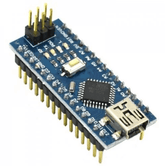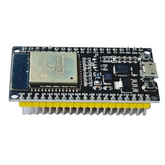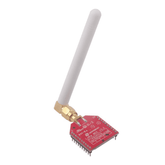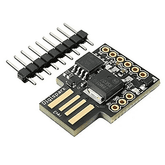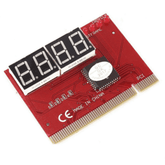Node to Node communication on LoRa with Arduino Nano and ESP32
What is LoRa?
LoRa, short for long-range, is the physical layer or the wireless modulation utilized to create a long-range communication link. LoRa is based on Chirp Spread Spectrum (CSS) modulation, which maintains the same low power characteristics as FSK modulation but significantly increases the communication range.
Material Required is as follows:
- Arduino Nano
- ESP32
- 2x LoRa Bee modules
- 4x 3.2K ohm Resistor
- 74LVC125A IC
- Jumper Wires
Circuit Diagram


Pin Details
ESP32
|
LoRa BEE |
LoRa BEE physical pin |
ESP32 Pin |
|
MISO |
4 |
D19(MISO)
|
|
RESET |
5 |
D14 |
|
MOSI |
11 |
D23(MOSI) |
|
D0 |
12 |
D2 |
|
NSS |
17 |
D5 |
|
SCK |
18 |
D22(SCLK) |
|
3V3 |
1 |
3V3 |
|
GND |
10 |
GND |
Arduino Nano
|
LoRa BEE |
LoRa BEE physical pin |
74LVC125A |
Arduino Nano |
|
MISO |
4 |
12
|
---- |
|
RESET |
5 |
---- |
D10 |
|
MOSI |
11 |
3 |
---- |
|
D0 |
12 |
----- |
D2 |
|
NSS |
17 |
8 |
---- |
|
SCK |
18 |
6 |
---- |
|
3V3 |
1 |
14 |
---- |
|
GND |
10 |
7 |
---- |
|
Arduino Nano |
74LVC125A |
|
MISO |
11 |
|
MOSI |
2 |
|
NSS |
9 |
|
SCK |
5 |
|
3V3 |
14 |
|
GND |
7 |
For node to node communication, the Nano will be configured as the Transmitter and the ESP32 will be configured as the receiver.
Step 1: Installing ESP32 Add-on in Arduino IDE
To install the ESP32 board in your Arduino IDE, follow below steps.
1. In your Arduino IDE, go to File> Preferences.
2. Enter https://dl.espressif.com/dl/package_esp32_index.json into the “Additional Board Manager URLs” field as shown in the figure below. Then, click the “OK” button.
3. Go to Tools > Board > Boards Manager
4. Search for “ESP32” and Click on the install button
5. The installation may take a while depending on your network performance. Once done, close the board manager
Step 2: Code and Library
Download as Zip file of Arduino-LoRa Library refer below link.
https://www.arduino.cc/reference/en/libraries/lora/
Installing library
1. In the Arduino IDE, navigate to Sketch > Include Library > Add .ZIP Library.
2. At the top of the drop-down list, select the option to "Add. ZIP Library''.
Step 3: Transmission Code
1. In your Arduino IDE, go to Tools > Board > Arduino Nano.2. Type in the code below and click on the Upload button to upload the code in the Arduino IDE.
#include <SPI.h>
#include <LoRa.h>
//define the pins used by the transceiver module
#define ss 10
#define rst 9
#define dio0 2
int counter = 0;
void setup() {
//initialize Serial Monitor
Serial.begin(115200);
while (!Serial);
Serial.println("LoRa Sender");
//setup LoRa transceiver module
LoRa.setPins(ss, rst, dio0);
//replace the LoRa.begin(---E-) argument with your location's frequency
//433E6 for Asia
//866E6 for Europe
//915E6 for North America
while (!LoRa.begin(866E6)) {
Serial.println(".");
delay(500);
}
// Change sync word (0xF3) to match the receiver
// The sync word assures you don't get LoRa messages from other LoRa transceivers
// ranges from 0-0xFF
LoRa.setSyncWord(0xF3);
Serial.println("LoRa Initializing OK!");
}
void loop() {
Serial.print("Sending packet: ");
Serial.println(counter);
//Send LoRa packet to the receiver
LoRa.beginPacket();
LoRa.print("hello ");
LoRa.print(counter);
LoRa.endPacket();
counter++;
delay(10000);
}
3. After uploading code open Arduino serial monitor to observe the data being transmitted.
Step 4: Receiver Code
1. In your Arduino IDE, go to Tools > Board > ESP32 Dev Module.
2. Type in the code below and click on the Upload button to upload the code in the Arduino IDE.
#include <SPI.h>
#include <LoRa.h>
//define the pins used by the transceiver module
#define ss 5
#define rst 14
#define dio0 2
void setup() {
//initialize Serial Monitor
Serial.begin(115200);
while (!Serial);
Serial.println("LoRa Receiver");
//setup LoRa transceiver module
LoRa.setPins(ss, rst, dio0);
//replace the LoRa.begin(---E-) argument with your location's frequency
//433E6 for Asia
//866E6 for Europe
//915E6 for North America
while (!LoRa.begin(866E6)) {
Serial.println(".");
delay(500);
}
// Change sync word (0xF3) to match the receiver
// The sync word assures you don't get LoRa messages from other LoRa transceivers
// ranges from 0-0xFF
LoRa.setSyncWord(0xF3);
Serial.println("LoRa Initializing OK!");
}
void loop() {
// try to parse packet
int packetSize = LoRa.parsePacket();
if (packetSize) {
// received a packet
Serial.print("Received packet '");
// read packet
while (LoRa.available()) {
String LoRaData = LoRa.readString();
Serial.print(LoRaData);
}
// print RSSI of packet
Serial.print("' with RSSI ");
Serial.println(LoRa.packetRssi());
}
}
- In receiver end, you can see the received packet
Troubleshooting
After uploading code if you are not receiving any packet into the receiver node follow the below steps
1. Make sure both node sender and receiver are working the same
Frequency. You can check so, by making sure the below line is the same in both receiver and transmitter code
while (!LoRa.begin(866E6))
2. Make sure the baud rate is set to 115200 in the Serial monitor for both the devices



